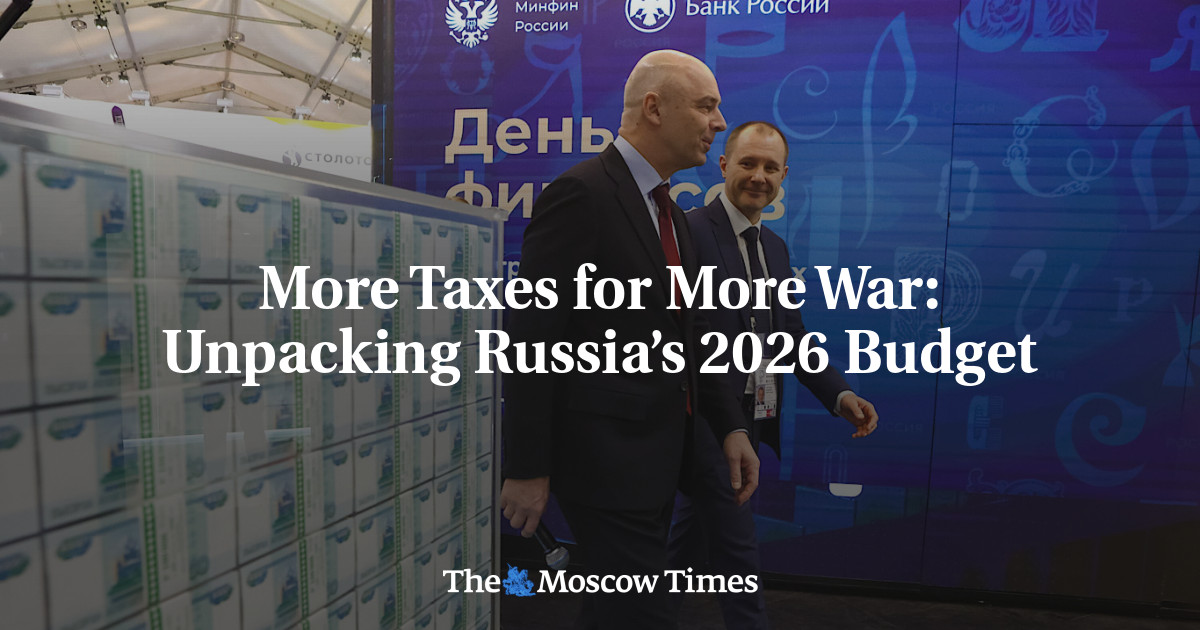
More Taxes for More War: Unpacking Russia’s 2026 Budget
How did your country report this? Share your view in the comments.
Diverging Reports Breakdown
More Taxes for More War: Unpacking Russia’s 2026 Budget
Russia’s draft federal budget for 2026 includes new tax hikes aimed at sustaining wartime spending. The biggest change is a planned increase in value-added tax (VAT) from 20% to 22%. The minimum annual revenue threshold for businesses to make payments is set to fall from 60 million rubles ($732,000) The occupied regions of Ukraine will see a major funding boost, with at least 60 billion rubles $732 million in additional subsidies planned in 2026. The Kremlin is taking a cautious, conservative approach to budget planning, neither cutting spending nor allowing it to rise beyond limits, an economist says. Western sanctions have hit oil and gas revenues hard, and Russia’s budget deficit is expected to widen. The proposed budget still requires approval from lawmakers in the State Duma, which will meet on November 14 to discuss the budget for the next fiscal year, which starts on January 1, 2026 and ends on March 31, 2027. The government expects to collect about 40.3 trillion rubles (about $491.7 billion) in revenue in 20 26.
Foreign policy priorities Although overall spending will remain broadly stable, budget allocations reveal that the Kremlin’s priorities continue to lie in foreign policy and defense. Defense and domestic security spending will make up around 38% of the budget in 2026 — only slightly less than the 40% share seen over the past two years. The occupied regions of Ukraine will see a major funding boost, with at least 60 billion rubles ($732 million) in additional subsidies planned for 2026 compared to the 2025 budget, the exiled outlet Vyorstka reported. The Russian-controlled part of the Donetsk region will receive the largest share at 77.8 billion rubles ($949.2 million) versus 54.5 billion ($664.9 million) in 2025, while subsidies for the Luhansk region will receive 55.5 billion rubles ($676.1 million), up from 37.8 billion ($461.2 million). Media and propaganda spending is also on the rise. The government intends to allocate 146 billion rubles ($1.78 billion) for mass media, up 6.6% from last year. About 25.96 billion rubles ($317 million) of this will go to the Institute for Internet Development, one of the Kremlin’s main vehicles for producing youth-oriented propaganda, the investigative website IStories reported. Other influence projects are expanding as well. The Russia in the World program — designed to promote “traditional spiritual and moral values” among foreign youth — will receive 11.9 billion rubles ($145.2 million) in 2026, more than double the 5.5 billion ($67.1 million) allocated in 2025, according to the investigative outlet Agenstvo. At the same time, traditional propaganda outlets like RT and the state television holding VGTRK are expected to lose around a third of their funding starting in 2027, IStories reported. While defense and propaganda budgets remain protected, several development programs will face cuts. Some of the reductions include rural development initiatives (down 30% to 81.5 billion rubles or $993 million), the aviation industry (-29.6% to 14.4 billion rubles or $175.7 million), and the energy sector (-28.6% to 17.9 billion rubles or $218.4 million).
Bank of Russia Governor Elvira Nabiullina at a plenary session of the State Duma State Duma
Funding for a regional primary care modernization program will plunge from 123.3 billion rubles ($1.50 billion) in 2025 to just 53.2 billion rubles ($649 million) in 2026. What is driving Russia’s budget strategy? Russia is being driven to increase taxes and moderate overall spending by three key factors. First, 2025 budget revenues fell short of expectations and widened the deficit. Oil and gas revenues are projected at just 8.65 trillion rubles ($105.5 billion) this year — 22% lower than the 11.13 trillion rubles ($135.8 billion) collected in 2024. The sluggish economy, expected to grow by just 1%, has also weighed on non-energy tax receipts. As a result, the deficit for 2025 is expected to reach 2.6% of GDP, the highest since the pandemic year of 2020. Under the new budget, the government aims to narrow the deficit to 1.6% of GDP in 2026. Second, the war in Ukraine is dragging on with no end in sight, and sanctions are likely to be tightened even further. That leaves Moscow in a bind. It cannot afford to cut defense spending — but it also does not want to run chronic deficits or stretch its finances to the breaking point, as doing so would reduce its resilience to possible future crises. Russia is now trying to balance the books and rebuild its reserves, or at least stop depleting them further. After years of heavy drawdowns, the liquid portion of the National Wealth Fund — held in foreign currency and gold — has fallen by roughly half since the invasion of Ukraine, leaving 3.92 trillion rubles ($47.8 billion). The government plans to finance next year’s spending through new debt and higher taxes while rebuilding the fund’s liquid reserves to 4.5 trillion rubles ($54.9 billion) by the end of 2026. Third, there is the problem of inflation, which remains stubbornly high largely because of Moscow’s sustained war-related spending and state subsidies. By keeping the budget closer to balance, the Finance Ministry hopes to cool price pressures and eventually enable the Central Bank to lower its key interest rate, which currently stands at 17%.
Donetsk Region after attack Stanislav Krasilnikov / TASS
